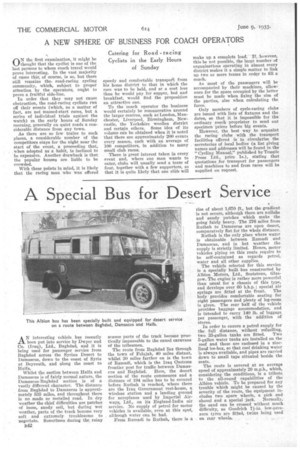A Special Bus for Desert Service
Page 56

If you've noticed an error in this article please click here to report it so we can fix it.
A N interesting vehicle has recently been put into service by Dwyer and Co. (Iraq), Ltd., Baghdad, and it is being used for passenger service from Baghdad across the Syrian Desert to Damascus, down to the coast of Syria at Beyrouth, and along the coast to Haifa.
Whilst the section between Haifa and Damascus is of fairly normal nature, the Damascus-Baghdad section is of a vastly different character. The distance from Baghdad to Damascus is approximately 535 milts, and throughout there is no made or metalled road. In dry weather the chief difficulties are patches of loose, sandy soil, but during wet weather, parts of the track become very soft and extremely troublesome to negotiate. Sometimes during the rainy
B42
season parts of the track become practically impassable to the camel caravans of the tribesmen.
The route from Baghdad lies through the town of Felujah, 40 miles distant, whilst 30 miles farther on is the town of Ramadi, which is the Iraq Customs frontier post for traffic between Damascus and Baghdad. Here, the desert section of the route commences and a distance of 194 miles has to be covered before Rutbah is reached, where there are the Iraq Government rest-house, a wireless station and a landing ground for aeroplanes used by Imperial Airways, Ltd., on its England-India air service. No supply of petrol for motor vehicles is available, even at this spot, although water can be had.
From flamed' to Rutbah, there is a rise of about 1,670 ft., but the gradient is not severe, althotigh there are nullahs and sandy patches which make the going fairly heavy. The 276 miles from Rutbah to Damascus are open desert, eomparatvely flat for the whole distance.
Rutbah is the only place where water is obtainable between Ramadi and Damascus, and in hot weather the supply is strictly limited. Hence, motor vehicles plying on this route req sire to be self-coutained as regards petrol, water and all other supplies.
The vehicle selected for this service is a specially built ;bus constructed by Albion Motors, Ltd., Scotstoun, Glasgow. The engine is rather more powerful than usual for a chassis of this type, and develops over 60 b.h.p.; special air springs are fitted at the front. The body provides comfortable seating for eight passengers and plenty of leg-room is given. The rear half of the vehicle provides baggage accommodation, and is intended to carry 140 lb. of luggage per passenger, with the addition of stores.
In order to ensure a petrol supply for the full distance, without refuelling,
two 35-gallon tanks are fitted. Two 5-gallon water tanks are installed on the roof and these are enclosed in a zinclined ice-box, so that cool drinking water is always available, and pipes are carried down to small taps situated beside the seats.
The route is covered at an average speed of approximately 20 m.p.h., which, considering the conditions, is a tribute to the all-round capabilities of the Albion vehicle. To be prepared for any trouble which might be caused by the severity of the route, the equipment includes two spare wheels, a pick and
shovel and a special jack. Normally, the sand can be crossed without much difficulty, as Goodrich 7A-in. low-pressure tyres are fitted, twins being used on rear wheels.




























































































